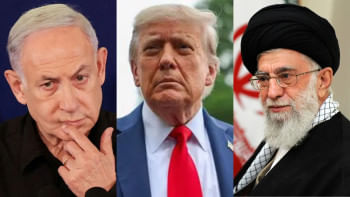BJP banking on Bengal as Mamata eyes Delhi

If West Bengal Chief Minister Mamata Banerjee nurtures larger ambitions to play a much bigger role at the national level after the ongoing parliamentary elections that by most accounts will produce a hung verdict, the Bharatiya Janata Party led by Prime Minister Narendra Modi is eyeing a good haul of seats in her state to help it extend its rule over India. This is the reason why West Bengal, with a total of 42 Lok Sabha seats up for grabs, has become one of six key battleground states after electorally bigger states (in terms of number of seats) of Uttar Pradesh and Maharashtra which have 80 and 48 seats, respectively. Bihar with 40 seats and Tamil Nadu with 39 are the other crucial states while heartland states of Madhya Pradesh, Rajasthan and Chhattisgarh together account for 62 seats.
But it is in West Bengal that the BJP is going all out to secure as many parliamentary seats as possible and has invested considerable political and financial capital for that over the last years. Bengal is one of the areas other than the seven northeastern states which together have 25 seats that the BJP is looking at to make up for the deficit in seats it might suffer in Uttar Pradesh, Maharashtra, Rajasthan, Madhya Pradesh and Chhattisgarh. In 2014, the BJP had won 60 seats in the heartland states, 71 seats in UP, and in Maharashtra, the party, along with its oldest Hindutva ally Shiv Sena, secured 41 seats.
There is recognition that it will be an uphill task for the BJP to repeat its 2014 performance in this group of states as the law of diminishing returns is likely to catch up. There are three main reasons for this: (i) the BJP faces double anti-incumbency for being in power in UP and in Maharashtra; (ii) the party lost elections to the Congress in the heartland states less than six months back; and (iii) it faces a challenge from a social coalition of powerful regional parties in the form of Samajwadi Party, Bahujan Samaj Party and Rashtriya Lok Dal in UP. In the absence of a pro-Modi wave this time, caste and religious identities are once again expected to shape division of votes in the poll in UP which may not see the kind of consolidation of Hindu votes witnessed in UP in 2014 national polls and in 2017 state assembly polls in the backdrop of the 2013 riots in Muzaffarnagar. Hence, the importance of Bengal and the northeast for the BJP.
Coming to West Bengal, at an election rally in Alipurduar not too long ago, BJP President Amit Shah had set his party's over-ambitious target of securing 23 out of the 42 seats in the state. By most accounts, the party is not likely to get more than five to six seats. Even at the height of the Modi wave in the run-up to the previous parliamentary poll in 2014, the BJP won just two seats against Trinamool Congress' 34. One wonders what the basis of Amit Shah's target of 23 is this time when the Modi magic has lost much of its appeal. Possibly, Shah is pinning his hopes on the steady surge in BJP's vote-share percentage in Bengal from only 6.1 in 2009 general elections when the party had managed just one seat (Darjeeling) to 16.8 in 2014.
There is no disputing the fact that BJP is an emerging force in Bengal's political landscape long dominated by Congress Party since independence in 1947 to 1977 and then by the Left parties till they were overthrown by Trinamool Congress in May 2011 after a 34-year unbroken rule. The last assembly elections in West Bengal in 2016 saw the BJP's vote share go up from 10.3 percent closing in on Congress' 12.4 percent. But this translated into just three assembly seats for BJP out of a total of 294 seats. The saffron party's growth in Bengal has been at the expense of the Left in the last five years. Many Left activists and supporters have switched over to the BJP which finished ahead of both the Communist Party of India (Marxist) and the Congress in 2018 Panchayat polls in the state.
But the BJP's main hurdle in Bengal is neither the Congress nor the Left; it's Trinamool Congress which is miles ahead of its rivals. In the 2014 parliamentary polls, Mamata's party bagged almost 40 percent of the total votes cast and a whopping 45.3 percent in the state assembly elections two years later securing 211 assembly seats, confirming its undisputed numero uno status in the state's politics. This is what makes Shah's much-vaunted target of securing 23 parliamentary seats in the current polls unrealistic and a nearly-impossible task for the BJP. The BJP cannot match Trinamool Congress in terms of organisational strength and the latter's expansive mass network in West Bengal.
But the biggest stumbling block for the BJP in Bengal is the absence of a charismatic Bengali leader. Modi may be a good communicator but Hindi-speaking star campaigners do not enjoy the same traction as Bengali-speaking Mamata and other Trinamool leaders. The paucity of BJP leadership in Bengal is evident by the fact that it needed a Hindi-speaking leader from faraway Madhya Pradesh, Kailash Vijayvargiya, to be in charge of party affairs in the state. Despite all this, if there is one party which is showing a semblance of challenge in the elections in the state, it is the BJP, as the Congress and the Left continue to see a decline in Bengal.
The BJP is trying to capitalise on anti-incumbency against Trinamool Congress through a combination of development deficit (lack of new industry and adequate number of jobs in the state) and a communally-polarising nationalist campaign narrative amplified by Indian warplanes' strike on a terror camp in Pakistan in February and by promising citizenship to all Hindu migrants from Bangladesh and identifying Muslim "infiltrators" by applying a Assam-like National Register of Citizens. This is likely to resonate with many in West Bengal as there's a growing perception in the state that Trinamool Congress is indulging in "minority appeasement." Muslims constitute about 30 percent of West Bengal's population—the highest in any Indian state—and their votes determine the outcome of elections in a number of seats. Obviously, Mamata cannot afford to be oblivious to Muslim voters. What the BJP is trying to do is trigger a consolidation of Hindu votes as a counter to Trinamool Congress. Among the parliamentary constituencies where the BJP is eyeing to fare well are Alipurduar and Cooch Behar (both of which went to polls in the first phase on April 11 drawing more than 81 percent turnout), Raiganj, Balurghat, Malda (north), Krishnanagar, Ranaghat, Purulia, Midnapore, Asansol, Kolkata (north), Howrah, Bongaon and Barrackpore. Many of these places are along the border with Bangladesh.
Pallab Bhattacharya is a special correspondent for The Daily Star.





Comments